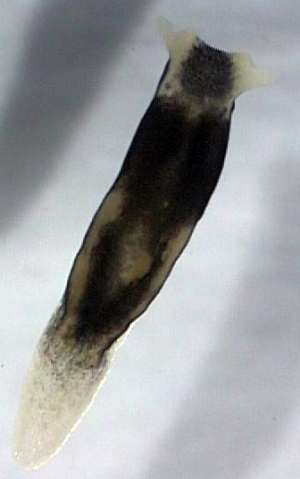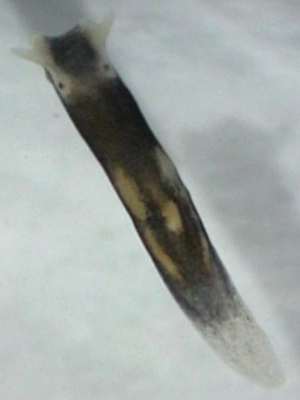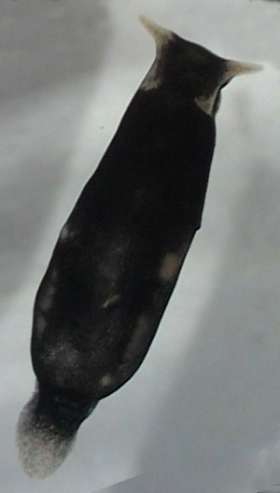
Limapontia senestra
(Quatrefages, 1844)
Order: SACOGLOSSA
Superfamily: LIMAPONTIOIDEA
Family: Limapontiidae
DISTRIBUTION
Northwestern Europe from Norway to Atlantic France and British Isles.
PHOTO
Fleet, Dorset, UK. August, 2003. Photo: Helen Marshall
Body-colour usually olive brown to black, with paler areas on either side of the head, including the rhinophores. There is also a characteristic pattern of colourless patches in the posterior half of the body, including a median patch and a series of patches on each side which can sometimes merge into a colourless band. This species is easily distinguishable from other species of Limapontia, at least as an adult, by the presence, in adults, of distinct and digitiform head tentacles [rhinophores]. Another characteristic feature is a swelling in the right lateral body wall, about midway down the body, caused by the bursa copulatrix [a sperm sac]. The anal and renal openings are situated close together in the postero-dorsal midline. This species grows to about 6mm and lives in fully saline intertidal pools and shallow water, often alongside L. capitata. It is reported to feed on the filamentous green algae, Cladophora. It mates by hypodermic impregnation. Larval development is direct, with no intracapsular veliger stage, the larvae hatching as small crawling slugs.
Reference:
• Thompson,T.E. (1976) Biology of Opisthobranch Molluscs. Volume 1. The Ray Society, London. 207pp.
Rudman, W.B., 2004 (March 8) Limapontia senestra (Quatrefages, 1844). [In] Sea Slug Forum. Australian Museum, Sydney. Available from http://www.seaslugforum.net/find/limasene
Related messages
Limapontia senestra from Britain
March 10, 2004
From: Helen Marshall

Hello Bill,
Thought you may be interested in the attached pictures. They are of Limapontia senestra (going by the finger-like head tentacles). They were collected from the Fleet, Dorset, UK, back in August. They were tricky to photograph due to their speed but I think the end result is OK! Hope they are of use!
Many regards,
Helen Marshall
202934@swansea.ac.uk


Thanks Helen,
It's surprising how little common animals like this are often the last to be photographed. As you say, they are very small and fast moving which makes macrophotography very difficult. I remember in the 1970s, Tom Thompson showing me this species and L. capitata during a trip I made with him to Plymouth, and I decided that since it was so abundant I would photograph it some other time - always a fatal mistake.
Apart from the obvious rhinophores in this species, it seems to have a rather characteristic pattern of colourless patches on the body. In your lower right photo, the swelling on the right side caused by the bursa copulatrix is quite clear. This is another character separating it from other species of Limapontia. This species, like a number of sacoglossans, mates by injecting its sperm directly through the body wall. I am not sure in this species whether the sperm then migrates to the bursa, or whether the slug has to aim for the bursa when they inject the sperm. In some species I think the theory is that a new bursa forms around the injected sperm. As you can imagine, this is all very difficult to study, as you need to kill, preserve and then cut histological sections of the animal to find out what is going on. There is always a chance that what you see is a result of the preparation of 'the specimen' rather than evidence of what really takes place.
Best wishes
Bill Rudman
